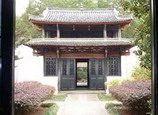
He is also a keen volunteer, working to connect experts in the field to create social movements for preservation of heritage. In 2010, he received an award from the State Bureau of Cultural Heritage Protection for his efforts as a volunteer, a proud moment that encourages him to be an example for young people and scholars.
Yao explained how the main challenge is now with the historical areas around the walls, the streets, the hutong and the neighborhoods.
He was proud to let us know that Nanjing is the only of the old capitals in China that has managed to keep its wall, its neighborhoods and river together.
"Beijing has hutong and Xi'an has its wall. In Nanjing we have both," Yao smiled.
He proudly talked about successful campaigns to preserve the old area and about improving living standards around Zhonghua Gate.
Ascending a ramp, it soon became evident just how much the city wall is part of daily life for the people here. With the wall as an impressive backdrop, a group of men were playing cards.
Nanjing hosts a kite festival every spring, during which many kites are flown from both on and off the wall. As I reached the top of Zhonghua Gate, I encountered a lone kite flyer. Next to him, an elderly woman were eagerly doing her exercises and stretching in the crisp afternoon sun.
Daily life, as it happens.
When I visited Zhonghua Gate, there were colorful decorative figures and banners all around. However, Yao does not approve of this way of decorating the heritage site.
"In my view, they are not allowed to do this, according to preservation laws," he said, explaining that one of the challenges is that the wall in many places are managed by the tourism, not the heritage department.



















![]()
